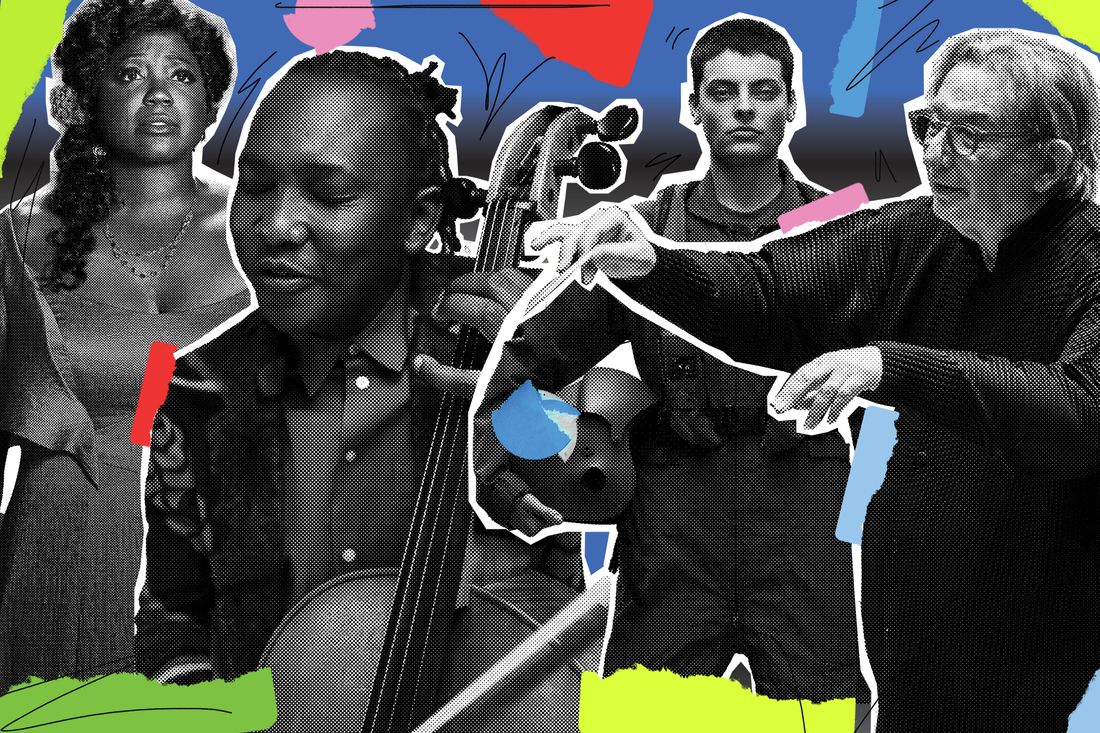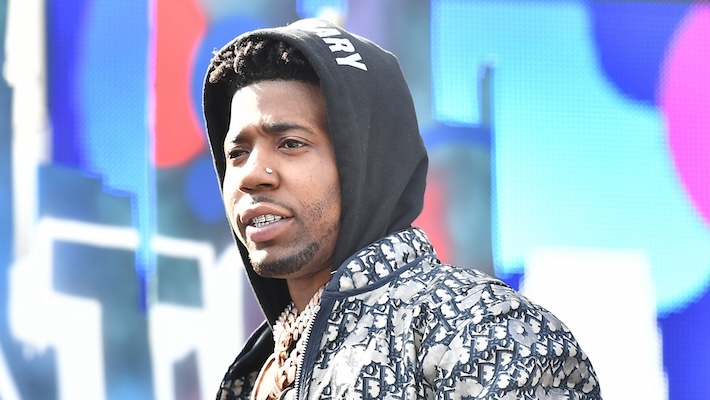
The fall concert season begins not just with the customary Beethoven and Bruckner but also with a great polychrome explosion of music from Latin America. The Venezuelan Gustavo Dudamel conducting a new work by the Mexican composer Gabriela Ortiz; a new chamber opera by Paola Prestini, who grew up on the Arizona side of border, about Mennonites who settled on the other; Lisetta Oropesa singing songs from Cuba; and the Argentinian-born Osvaldo Golijov’s opera Ainadamar at the Met: It’s enough to make you reassess classical music’s lineage. Miller Theatre, September 12 The New Orleans–born pianist and composer, whose music incorporates a wide range of Black and American idioms, gets her own showcase.
David Geffen Hall, September 12, 13, and 15 Every performance led by Michael Tilson Thomas is an unexpected gift now. Although he has drastically cut back on conducting since a diagnosis of glioblastoma in 2021, he’s scheduled to open the Philharmonic season with one of his calling cards: Mahler’s Symphony No. 5.

Alice Tully Hall, September 16 David Robertson anchors the school’s interdisciplinary fall festival, conducting the crackerjack student orchestra in a new work by Katie Jenkins along with Schoenberg’s Piano Concerto and Beethoven’s Fifth. Metropolitan Opera, Opens September 23 The routine of a high-tech remote warrior, steering a lethal drone from a room in Nevada, might not seem operatic, but it is the stuff of Jeanine Tesori’s Met Opera debut. The new work, with a libretto by George Brant based on his own play, stars mezzo-soprano Emily D’Angelo as the pilot.
Park Avenue Armory, September 23–October 6 Meredith Monk’s latest music-and-dance ritual expands to fit the immense Drill Hall. National Sawdust, September 26–29 Paola Prestini’s new opera, about love among the Mennonites in Mexico, promises onstage nudity and an “olfactory” experience as well as Prestini’s score, which includes a lot of silence amid the abundance of sounds. Carnegie Hall, October 8–10 While the New York Philharmonic awaits the arrival of Gustavo Dudamel, who will become its music and artistic director in 2026, he and his current orchestra open the Carnegie Hall season with three programs heavy on Latin American music, including a new cello concerto by Gabriela Ortiz for Alisa Weilerstein and an evening with the Mexican singer-songwriter Natalia Lafourcade.
Metropolitan Opera, Opens October 15 The soprano Angel Blue headlines the Met premiere of Osvaldo Golijov’s flamenco-tinged, dance-heavy opera, based on the life of Federico García Lorca. Geffen Hall, October 17 and 18 The New York Philharmonic performs music from the African diaspora, including recent works by Carlos Simon, Nathalie Joachim, David Baker’s 1973 Kosbro , and William Grant Still’s 1947 Autochthonous symphony. Carnegie Hall, October 18 Gabriela Ortiz, this year’s resident composer at Carnegie Hall, supplied the music for a multimedia extravaganza based on a mural-size drawing by James Drake.
Vocal ensemble the Crossing performs alongside choreography by Harrison Guy. Steve Jiménez directs. 92nd Street Y, October 23 Shaw, a Pulitzer Prize–winning composer and vocalist, and the country’s premier percussion ensemble perform music from their collaborative new album, Rectangles and Circumstance.
Zankel Hall, October 23 The great soprano plays hooky from her usual home at the Met and, accompanied by pianist Ken Noda, gives a more intimate recital of Spanish and Spanish-ish music by Rossini, Delibes, Nin, and Lecuona. Miller Theatre, October 24 The keyboard virtuosos pool their fingers to perform a two-piano arrangement of Beethoven’s Sixth Symphony plus Mozart’s two-piano sonata and more music by Philip Glass and Pēteris Vasks. Zankel Hall, October 26 The South African cellist belongs to a generation of musicians who slip from genre to genre, style to style, Africa to Europe, as easily as if they were crossing state lines.
An improviser and singer who is also confident in the classics, Selaocoe tours with his own backup band. The Church of Saint Mary the Virgin, October 26 Part of Miller Theatre’s early-music series, the English vocal ensemble performs reverent music old and recent by William Byrd and Arvo Pärt. 92nd Street Y, November 1 The dream threesome — Stefan Jackiw on violin, Jay Campbell on cello, and Conrad Tao on piano — tear through a program of Shostakovich, Brahms, and Zorn.
Geffen Hall, November 7–9, 12 Santtu-Matias Rouvali conducts music for three phases o f life: Julia Wolfe’s Fountain of Youth, Sibelius’s mid-life Fifth Symphony, and the aged Strauss’s Four Last Songs , sung by Miah Persson. Alice Tully Hall, November 9 A program of well-buffed classics: Tenor Polenzani sings Schubert’s magnificently tragic song cycle, and members of the Chamber Music Society of Lincoln Center perform Schumann’s Piano Quintet. 92nd Street Y, November 10 The group, which has been fattening the quartet repertoire with a steady diet of commissions and premieres, performs four of them, by Eduardo Aguilar, Seare Farhat, Juri Seo, and Anthony Cheung.
Carnegie Hall, November 14 The veteran conductor Louis Langrée, who led the Mostly Mozart Festival for more than 20 years, makes his belated Carnegie Hall debut with an old favorite: Beethoven’s Seventh. Sterling Elliott plays Haydn’s D-major cello concerto. Geffen Hall, November 14 and 16 Adams leads the New York Philharmonic in an urban diptych — his own City Noir and Copland’s Quiet City — along with evocations of landscape by Gabriella Smith.
Park Avenue Christian Church, November 16 The early music ensemble Tenet narrates the story of Ariadne and Theseus, told through an assortment of 17th century Italian composers: Barbara Strozzi, Monteverdi, etc. 92nd Street Y, November 17 Music by Scarlatti and the classical guitarist’s obligatory showpiece, Rodrigo’s Concierto de Aranjuez . Carnegie Hall, November 17–19 The world’s most prestigious orchestra, led by Kirill Petrenko, returns with Rachmaninoff’s The Isle of the Dead , Dvorák’s Symphony No.
7, and Korngold’s Violin Concerto, played by Hilary Hahn. Two performances of the same program sandwich one of Bruckner’s Symphony No. 5 in between.
Carnegie Hall, November 22 and 23 The orchestra’s prodigiously young new chief, Klaus Mäkelä, leads the meatiest of early-20th-century composers — Rachmaninoff, Mahler, and Schoenberg — plus a new work by Ellen Reid. Lisa Batiashvili performs Prokofiev’s Second Violin Concerto. Zankel Hall, December 3 Davies’s voice, so light and pure it’s almost transparent, is the ideal vehicle for the 17th-century sacred lamentation by the likes of J.
C. Bach, Tunder, Scheidt, Schein, Buxtehude. Geffen Hall, December 5–7 The artist William Kentridge assembled this film, about the Soviet Union and its artists, from shots of photos, newspaper cuttings, lithographs, bronze sculptures, costumes, and puppets.
One of the most important ingredients is Shostakovich’s wild, jubilant, tragic Symphony No. 10, which the New York Philharmonic, led by Keri-Lynn Wilson, will perform live. National Sawdust, December 8 Liverman, who jumped to Met Opera stardom with starring roles in Fire Shut Up in My Bones and X: The Life and Times of Malcolm X , brings his own new song cycle to this far more intimate Williamsburg venue, which is celebrating its tenth anniversary.
92nd Street Y, December 12 Denk’s repertoire ranges widely, but at its heart is always Ives’s fantastically gnarled Concord Sonata , which he plays like nobody else. He fills out the program with music by Gottschalk, Bolcom, Joplin, and Beethoven. Carnegie Hall, December 15 The two siblings, who have shown they can sell out Zankel Hall, have now graduated to the big room upstairs for a program of Fauré, Poulenc, Mendelssohn, and Natalie Klouda.
Thank you for subscribing and supporting our journalism . If you prefer to read in print, you can also find this article in the August 26, 2024, issue of New York Magazine. Want more stories like this one? Subscribe now to support our journalism and get unlimited access to our coverage.
If you prefer to read in print, you can also find this article in the August 26, 2024, issue of New York Magazine..














